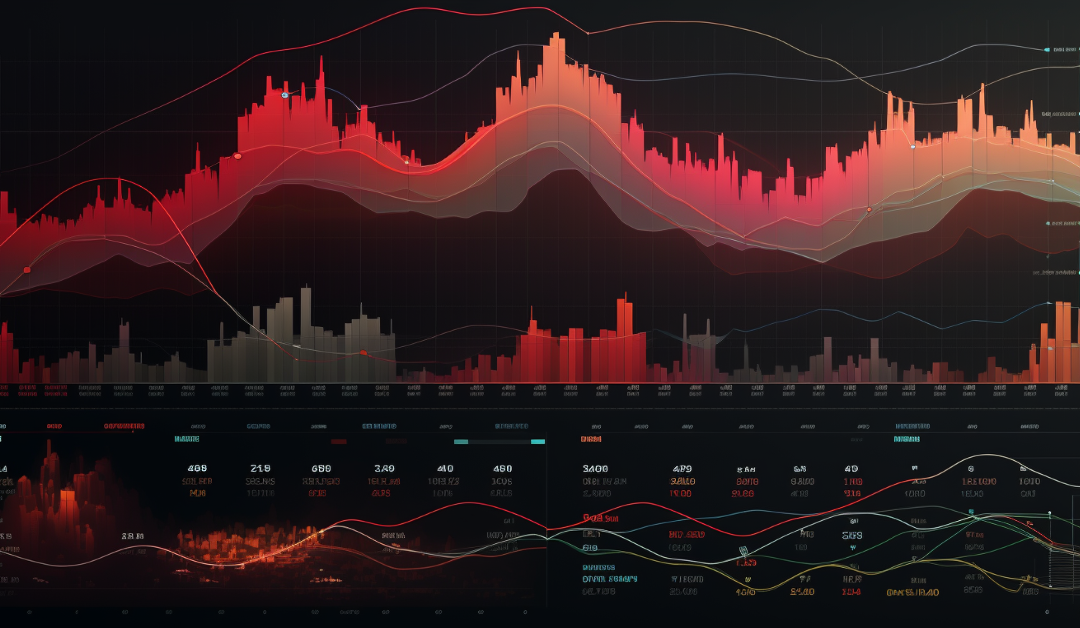
by Leroy Prince | Apr 10, 2024 | Banking
Key points
- Home owners in the US are continuing to take mortgages despite high interest rates.
- Applications to refinance homes has now jumped 10% in the past week which is 4% higher than the same period YoY.
- Applications for new homes mortgages fell 5% for the week and also 23% lower YoY.
US home owners have increased their demand for home refinancing mortages over the past week despite interest rates being as high as 7% at the moment. However, the demand for mortgages for new homes has fallen significantly within the same period.
House owners continue to take mortgages in the US despite high interest rates
2023’s rising inflation rates saw the US Federal Reserve raise interest rates several times. Till now, it is yet to cut the rates back as it fears that inflation is still not stable. As a result, the cost of loans and mortgages has been going up within the past 18 months as a result of the hikes in interest rates.
As such, it would be expected that fewer people would be seeking to finance their homes or other assets. Refinance demand usually drops in the event of rates hikes but the rates had fallen back slightly over the past weeks. Also, there is hope in the market that the Federal Reserve will not be increasing rates as it is anticipating for further cuts as the year goes by.
According to data from Mortgage Bankers Association, total mortgage application volume increased by 0.1% over the past week. Applications for home refinancing loans jumped 10% for the week, which is 4% higher YoY. In the same time, the average contract interest rate for a 30-year fixed-rate mortgage with matching loan balances ($766,550 or less) rose to 7.01% from 6.91%, with points remaining at 0.59 (including the origination fee) for the loans that have a 20% down payment.
“Mortgage rates moved higher last week as several Federal Reserve officials reiterated a patient posture on rate cuts. Inflation remains stubbornly above the Fed’s target, and the broader economy continues to show resiliency. Unexpectedly strong employment data released last week further added to the upward pressure on rates,” said Joel Kan, MBA’s vice president and deputy chief economist.
Now, investors are waiting for key inflation dta that releases later today, and depending on the report, mortgage rates could have sharp movements to either directions.
This material is meant for educational and recreational purposes only. It is not financial advice in any way; therefore, damage caused by the information provided here is not liable to the company or the writer in question. Please make due diligence and conduct your own research before taking any action prompted by the information provided above.
For more resources like this one, keep watching our website and remember to follow our socials to stay ahead of the curve. Thanks for believing in us. Your support is appreciated.
X.com Linkedln Truth Social Reddit
Do you like our content and would love to support us more? You can use these addresses.
Ethereum: 0xe6814Bf3B50691BC1697E4B2717f5d204b67C7f6
Bitcoin: bc1qpeuuw7szfdkqd7hp66uhkas4huha8qkwxdgxtg
BNB Chain/BEP 20: 0xe6814Bf3B50691BC1697E4B2717f5d204b67C7f6

by Gary Smith | Apr 3, 2024 | Banking
Key points
- Inflation still runs wild in Turkey at 68.5%.
- Education cost had the highest inflation by 104% YoY, followed by hotels and eateries at 95% and health at 80%.
Turkey’s inflation data shows increased inflation rates despite the central bank imposing continued rate hikes. Inflation rates are now 68.5%, up from February’s 67.1%.
Turkey’s inflation is still running wild
Despite efforts by Turkey’s Central Bank to push interest rates from 45% to 50%, inflation still runs wild. Much of the inflation rise is due to a policy to increase the minimum wage for 2024 to 17,002 Turkish Lira ($530) per month, a 100% hike YoY.
This hike risks the country experiencing embedded inflation. As such, economists expect further interest rate hikes to be announced to tame the wild inflation. However, this process is likely challenging, considering that the Turkish Lira has lost over 81% of its value against the dollar in five years.
Hope remains for the Turkish people as their Central Bank has been busy working on a turnaround policy to ease the pain in the markets and stabilize the Lira. This also shows that the Central Bank now has greater independence and is in a position to make the situation much easier going forward. However, only time will tell what happens now.
This material is meant for educational and recreational purposes only. It is not financial advice in any way; therefore, damage caused by the information provided here is not liable to the company or the writer in question. Please make due diligence and conduct your own research before taking any action prompted by the information provided above.
For more resources like this one, keep watching our website and remember to follow our socials to stay ahead of the curve. Thanks for believing in us. Your support is appreciated.
X.com Linkedln Truth Social Reddit
Do you like our content and would love to support us more? You can use these addresses.
Ethereum: 0xe6814Bf3B50691BC1697E4B2717f5d204b67C7f6
Bitcoin: bc1qpeuuw7szfdkqd7hp66uhkas4huha8qkwxdgxtg
BNB Chain/BEP 20: 0xe6814Bf3B50691BC1697E4B2717f5d204b67C7f6

by Joseph Reagan | Apr 3, 2024 | Banking
Key points
- Inflation in the Eurozone slowed to 2.4% in March, a number lower than expected.
- The dip increases the chances of interest cuts later in the year.
20 nation region, the Eurozone just received an economic boost after recording lower inflation rates (2.4%) than expected. The region has been battling harsh economic policies like hiked interest rates to deal with wild inflation since 2023, but now it’s expected that the central bank will reverse this course in June or July.
Eurozone’s economy performs better than expected
Since 2023, the ECB has been hiking interest rates to fight wild inflation rates that almost pushed the Eurozone into a financial breakdown. The inflation rates spiked in the aftermath of the COVID-19 pandemic, saw most governments overstretch their financial abilities to curb the outbreak, and many economies face shutdowns due to health lockdowns.
Throughout 2023, inflation rates worldwide have fallen due to the designated Central Banks imposing higher and higher interest rates. While this has been causing pain in the markets, it was necessary to avoid the occurrence of embedded inflation.
The Eurozone has not been any different. Its economy has been on a similar trajectory; however, it’s now showing signs of fast recovery, which is expected to ease pain in the markets by cutting interest rates. According to information published on Wednesday, the inflation rate in the region fell to 2.4%.
The region’s core inflation rate also fell from 3.1% to 2.9% in March, excluding energy, food, alcohol, and tobacco. Another economic recovery indicator that the ECB released was unemployment data. It fell to 6.5% in February, lower than 6.6% in January. Now, markets expect the Eurozone’s Central Bank to start lowering interest rates in June, a position reflected in a recent message from key figures in the ECB.
This material is meant for educational and recreational purposes only. It is not financial advice in any way; therefore, damage caused by the information provided here is not liable to the company or the writer in question. Please make due diligence and conduct your own research before taking any action prompted by the information provided above.
For more resources like this one, keep watching our website and remember to follow our socials to stay ahead of the curve. Thanks for believing in us. Your support is appreciated.
X.com Linkedln Truth Social Reddit
Do you like our content and would love to support us more? You can use these addresses.
Ethereum: 0xe6814Bf3B50691BC1697E4B2717f5d204b67C7f6
Bitcoin: bc1qpeuuw7szfdkqd7hp66uhkas4huha8qkwxdgxtg
BNB Chain/BEP 20: 0xe6814Bf3B50691BC1697E4B2717f5d204b67C7f6

by admin | Mar 30, 2024 | Banking
Introduction
Certificate of Deposits (CDs) are a popular and low-risk investment option for individuals seeking to earn a fixed rate of return on their savings. One of the key decisions when investing in CDs is selecting the right term, which refers to the length of time your money will be locked into the CD before it matures. With various CD terms available, it’s essential to consider your financial goals, liquidity needs, and interest rate expectations when choosing the right CD term. Here’s a comprehensive guide to help you make an informed decision:
1. Assess Your Financial Goals:
Before choosing a CD term, it’s crucial to assess your financial goals and investment objectives. Consider factors such as your timeline for accessing the funds, your risk tolerance, and your overall financial situation. Are you saving for a short-term goal, such as a vacation or emergency fund, or are you investing for long-term growth and stability? Understanding your goals will help you determine the appropriate CD term for your needs.
2. Consider Your Liquidity Needs:
CDs are known for their fixed terms, which means your money will be tied up for a specified period without easy access to it. When choosing a CD term, consider your liquidity needs and whether you can afford to lock away your funds for the duration of the term. If you anticipate needing access to your money before the CD matures, opt for a shorter-term CD or explore alternative options that offer more flexibility.
3. Evaluate Interest Rate Expectations:
Interest rates play a significant role in determining the yield and attractiveness of CDs. Generally, longer-term CDs offer higher interest rates than shorter-term CDs to compensate investors for locking in their money for an extended period. Evaluate current interest rate trends and economic forecasts to gauge whether it makes sense to lock in a higher rate with a longer-term CD or opt for a shorter-term CD with the potential to reinvest at higher rates in the future.
4. Assess Penalties for Early Withdrawal:
Most CDs impose penalties for early withdrawal, meaning you may incur fees or forfeit a portion of your interest earnings if you access your funds before the CD matures. Before committing to a CD term, carefully review the terms and conditions regarding early withdrawal penalties. Consider whether the potential penalties outweigh the benefits of locking in your funds for the specified term and factor this into your decision-making process.
5. Utilize a CD Laddering Strategy:
One approach to optimizing your CD investments is to employ a CD laddering strategy. This involves dividing your investment into multiple CDs with staggered maturity dates. By diversifying your investments across different CD terms, you can balance liquidity needs, take advantage of higher interest rates on longer-term CDs, and maintain a steady stream of income as CDs mature and funds become available for reinvestment.
6. Consider Your Risk Tolerance:
While CDs are generally considered low-risk investments, it’s essential to consider your risk tolerance when choosing a CD term. Longer-term CDs offer higher yields but also entail locking in your funds for an extended period, which may expose you to the risk of inflation or missed opportunities if interest rates rise in the future. Evaluate your comfort level with potential fluctuations in interest rates and choose a CD term that aligns with your risk tolerance and investment objectives.
7. Monitor Market Conditions:
Stay informed about changes in interest rates, economic indicators, and market conditions that may impact CD rates and returns. Monitor interest rate movements and adjust your CD investment strategy accordingly to capitalize on opportunities or mitigate risks. By staying vigilant and proactive, you can optimize your CD investments and maximize your returns over time.
Conclusion
In conclusion, choosing the right CD term requires careful consideration of your financial goals, liquidity needs, interest rate expectations, and risk tolerance. By assessing these factors and conducting thorough research, you can select a CD term that aligns with your investment objectives and helps you achieve your long-term financial goals. Whether you opt for a short-term CD for immediate liquidity or a long-term CD for higher yields, strategic CD investing can play a valuable role in building a diversified and secure investment portfolio.
This material is meant for educational and recreational purposes only. It is not financial advice in any way; therefore, damage caused by the information provided here is not liable to the company or the writer in question. Please make due diligence and conduct your own research before taking any action prompted by the information provided above.
For more resources like this one, keep watching our website and remember to follow our socials to stay ahead of the curve. Thanks for believing in us. Your support is appreciated.
X.com Linkedln Truth Social Reddit
Do you like our content and would love to support us more? You can use these addresses.
Ethereum: 0xe6814Bf3B50691BC1697E4B2717f5d204b67C7f6
Bitcoin: bc1qpeuuw7szfdkqd7hp66uhkas4huha8qkwxdgxtg
BNB Chain/BEP 20: 0xe6814Bf3B50691BC1697E4B2717f5d204b67C7f6

by Leroy Prince | Nov 10, 2023 | Banking
Key Points
- UK’s Gross Domestic Product has shown no growth in Q3 2023 after registering a slight rise of 0.2% in Q2.
- The UK Finance Minister now decries high inflation, blaming it as the “greatest barrier” to their economic growth.
Inflation rates in the UK are still running wild and have halted economic growth in Q3 2023. The country had a flatlined GDP in the quarter per initial figures revealed on Nov. 10.
UK GDP flatlines in Q3 2023
There was no quarterly growth in the past three months ending September in the UK despite Q2 showing a slight increase of 0.2%. While inflation rates remain higher in the country, it’s still not as tight as it was in the previous year.
The UK Q3 GDP is 0.6% higher than what was recorded in 2022, but there is still more to be done for the economy to experience a near-full recovery. The Finance Minister Jeremy Hunt said that inflation remains the “single greatest barrier to economic growth” in the country, with the Consumer Price Index showing 6.7% YoY in September.
Hunt continued:
“The best way to sustainably grow our economy right now is to stick to our plan and knock inflation on its head.”
He added that their Autumn Statement would focus on how they can get the economy growing healthily again by unlocking investments and getting people to work by reforming public services to allow them to deliver the growth that the country needs.
This material is meant for educational and recreational purposes only. It is not financial advice in any way; therefore, damage caused by the information provided here is not liable to the company or the writer in question. Please make due diligence and conduct your own research before taking any action prompted by the information provided above.
For more resources like this one, keep watching our website and remember to follow our socials to stay ahead of the curve. Thanks for believing in us. Your support is appreciated.
X.com Linkedln Truth Social Reddit
Do you like our content and would love to support us more? You can use these addresses.
Ethereum: 0xe6814Bf3B50691BC1697E4B2717f5d204b67C7f6
Bitcoin: bc1qpeuuw7szfdkqd7hp66uhkas4huha8qkwxdgxtg
BNB Chain/BEP 20: 0xe6814Bf3B50691BC1697E4B2717f5d204b67C7f6

by Chelsea Florence | Nov 9, 2023 | Banking
Key Points
- Global banking giant Standard Chartered is eyeing setting up a crypto fund in the United Arab Emirates.
- The disclosure comes days after the UAE issued guidance on crypto regulation requiring VASPs to be licensed to increase the transparency of financial systems in the country.
Standard Chartered’s SC Ventures seeks to establish a Digital Asset Joint Venture investment company in partnership with Japan’s SBI holdings in the UAE.
UAE continues working towards becoming a global crypto hub
In a Nov.9 Press release, SC Ventures revealed that the new venture in the UAE would be a joint effort with Japanese Financial Conglomerate SBI Holdings aiming ‘to make strategic and minority investments’ in areas of interest like ‘market infrastructure, DeFi, Tokenization, COnsumer payments’ among others.
The CEO of SC Ventures, Alex Manson, also indicated a strong interest in Risk management, tokenization, and compliance tools as key aims of the new venture. He highlighted the region’s efforts and new role in becoming a fintech hub due to its strengthening infrastructure and talent.
UAE has been working on attracting more fintech investors and getting a better reputation globally for its financial products. On Nov 8, Fintech Express reported that the country had released a new guidance list for those looking to set up virtual assets services provision systems there. In the list, the country highlights some red flags of common untrustable crypto deals and warnings to service providers who want to continue working in the region.
The country is introducing these measures, eyeing to get out of the FATF’s ‘Grey List’ of countries with questionable financial systems. Thus increasing its chances of incorporation with the mainstream word finance and, thus, a better future. While SC Ventures is set to be the next new thing in the country’s financial landscape, Manson has confirmed that it will not limit itself to the regional market but will “explore the emerging digital asset ecosystem opportunities globally.”
This material is meant for educational and recreational purposes only. It is not financial advice in any way; therefore, damage caused by the information provided here is not liable to the company or the writer in question. Please make due diligence and conduct your own research before taking any action prompted by the information provided above.
For more resources like this one, keep watching our website and remember to follow our socials to stay ahead of the curve. Thanks for believing in us. Your support is appreciated.
X.com Linkedln Truth Social Reddit
Do you like our content and would love to support us more? You can use these addresses.
Ethereum: 0xe6814Bf3B50691BC1697E4B2717f5d204b67C7f6
Bitcoin: bc1qpeuuw7szfdkqd7hp66uhkas4huha8qkwxdgxtg
BNB Chain/BEP 20: 0xe6814Bf3B50691BC1697E4B2717f5d204b67C7f6






